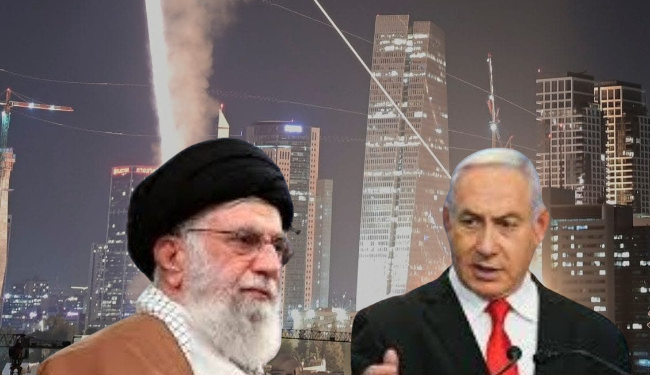
- The conflict exposes the limitations of international entities like the UN and proves the adage of MIGHT BEING RIGHT.
- If the conflict lasts for more than two weeks, then Israel will be forced to look at nuclear options, as it cannot sustain this conflict in the non-nuclear sphere.
- To break the strong Iranian Missile and AD network, Israel’s initial strike included the use of trailer-truck drones — the same tactic that Ukraine used on June 1 against Russia’s strategic air assets.
- Israel saw that Western influence is waning and that new technologies have given its foes, like Hamas and Hezbollah, the ability to inflict precise, damaging attacks with low-cost weapons.
Middle East is once again witnessing kinetic action between historical enemies Israel and Iran. In part one of this two-part article, we will look at the reasons for the latest flare-up and analyse possible options for both actors. Part two will look at the changing landscape of war and lessons that Bharat can learn from it.
On June 13, Israel added another of its neighbours to the long list of regional nations it is currently bombing. From Lebanon, Palestine, Syria, Iraq, Yemen, international waters, and now Iran, Israel now bombs them all with impunity while crying out about its own ‘security’. Iran is the most formidable of all Arab nations. Not only does it have a formidable army with sophisticated missiles & drones, but it also has an extensive network of proxies (Houthis, Hamas, Hezbollah) which enable it to conduct operations with plausible deniability. Israel astutely identified the danger emanating from Iran & its proxies. It created the grounds for war over the last 40 years through sustained narrative building.
Weaponising the Narrative
Israeli Newspapers in 1984 brought out the narrative that Iran was in the final stages of developing a Nuclear bomb. In his book titled Fighting Terrorism, Benjamin Netanyahu in 1995 claimed that Iran would develop Nuclear weapons in 2-3 years.

As brought out above, a sustained campaign to build a narrative to paint IRAN as a fundamentalist regime with aspirations to use nuclear weapons against Israel was built over decades. Iran tried to blunt this narrative by signing the NPT (Nuclear Nonproliferation Treaty) in 1970 and its amendment in 1996. The supreme leader of Iran, Ayatollah Khomeini, issued a FATWA in 2004 proclaiming that nuclear weapons were HARAM. Israel, with its western sponsors controlling the English print and media, was successful in painting Iran as a rogue state and itself as the victim.
Neutralising the Proxies, Isolating the Core
The strength of Iran lay in its proxies (Hamas/Hezbollah & Houthis) and friendly regimes (Assad’s regime in Syria). Israel’s strategy was to blunt this strength of Iran and then take on Iran itself. Operations against Hamas, Hezbollah were initiated in 2024-25, and the entire leadership of Hamas & Hezbollah were taken out by targeted actions. This ensured that the flanks (home front) were safe from plausible deniability actions initiated by Iran (carried out by proxies). The Syrian pro-Iranian regime was taken out by a coordinated action with Turkey, using terrorist groups spearheaded by HTS. These actions left Iran isolated in the region and vulnerable to attack. To break the strong Iranian Missile and AD network, Israel’s initial strike included the use of trailer-truck drones — the same tactic that Ukraine used on June 1 against Russia’s strategic air assets. Israel appears to have had more success than the Ukrainians because the Zionist drones carried out some successful assassinations of senior Iranian military leaders and some prominent nuclear scientists. Air strikes that followed hit nuclear enrichment facilities, Army leaders, scientists and missile bases.
Iran was caught in a web of deception. The US was engaging in nuclear deal negotiations with it, and the 6th round was slated for the 14th of June. Iran believed that any action by Israel would happen post-negotiations. It was dulled into a false sense of security. The lack of good communication security (Comsec) and counter intelligence enabled Mossad to do targeted assassinations of its top leadership including General Salami of the IRGC, Chief of Staff Mohammad Bagheri, and top nuclear scientist Fereydoon Abbasi crippling any response to the air attack. Iran had failed to learn from the assassination of HAMAS leader Ismail Haniyeh (31st July 2024), who was assassinated along with his bodyguard in the Iranian cap, ital Tehran by an Israeli attack. Haniyeh was killed in his accommodation in a military-run guesthouse after attending the inauguration ceremony for Iranian president Masoud Pezeshkian.
(Mis)Use of IAEA
Israel’s attack was part of a planned international intelligence and military operation, which included the participation and support of the United States, the United Kingdom, France and Germany. On May 31, when a UN watchdog issued two reports designed to create a narrative that Iran is a rogue nuclear state:
- A report issued by the International Atomic Energy Agency (IAEA) and sent to member states on Saturday said Iran’s stock of uranium enriched to up to 60 per cent purity had grown by roughly half to 408.6 kg. That is enough uranium, if enriched to the 90 per cent purity level, for nine nuclear weapons, according to an IAEA estimate.
- The second report claims that Iran carried out secret nuclear activities with material not declared to the UN nuclear watchdog at three locations decades ago.
This tactic was employed in 2002/2003 to justify the attack on Iraq, which the US insisted had weapons of mass destruction. We now know it was a lie, but the propaganda was effective in producing support in the US and Europe to invade Iraq. The same tactics are being used today by Israel and the West, only this time, Iran is being falsely accused of enriching uranium to build a bomb. The Iraq WMD lie, like the current calumny against Iran, only has one purpose… justify military action to achieve regime change.
Technology and Timing
Israel’s decision to strike at Iran now is a result of geopolitical and technological reasons. Israel rightly analysed that the West on which it banks for support is steadily losing ground in the world. The rise of the global south and the decimation of NATO by Russia were markers in this fast-changing landscape. Secondly, nascent technologies have created parity between Israel and its foes, where groups like Hamas and Hezbollah can use cheap but highly technologically effective weapons to deal accurate, disabling damage to Israel’s most critical and sensitive infrastructure. The same goes for Iran: the country has come of age and mastered rocketry/drone warfare to the point where the numbers simply do not work in Israel’s favour in any future war. IDF’s failure to control Gaza despite having overwhelming superiority pointed to the changing dynamics of warfare. It therefore does not surprise me that Israeli officials seized this moment before the above trends make victory impossible.
Strategic Options Ahead for Israel and Iran
Having delivered the first strike, the immediate goal will be to defend against the inevitable backlash of missile and drone strikes from Iran. As Missiles/drones have to fly across Syria, Jordon or Iraq to reach Israel. Israel and its allies (the US/UK/France/Germany) will use their air forces to provide defence against these threats. Ballistic missiles, particularly Hypersonic missiles, are likely to get through and hurt Israel. BDA (Battle Damage Assessment) will be carried out t Iranian targets that were hit to reinitiate fresh attacks. In the event of damage to Negev Nuclear Research Center, Dimona Nuclear facilities or other key installations, Israel will strike against Iran’s oil and gas facilities crippling its economy. The ultimate goal will be to initiate a regime change operation and ensure that Iran is headed by people subservient to its interests. Israel’s weakness is its lack of strategic depth and weak demographics. It cannot sustain a prolonged conflict and will look to end this conflict with a decisive strike and create conditions in Iran for a regime change. Israel will try to bring the US into the conflict to sustain itself if it prolongs.
The immediate goal will be to reorganise the armed forces and bring cohesion to counter the air threat faced. Counterintelligence operations will be initiated to ensure the protection of key personnel and assets. In 2024 (Operation Promise 1 & 2), Iran didn’t strike at Israeli cities or key command centres. I believe that this time, given the provocation, Iran will hit Israeli cities and key command posts. One tactic that Iran may employ is to fire older missiles and drones in a first or second wave attack to deplete Israel’s air-defence system. Iran can then follow up with launches of hypersonic missiles. The Iranian regime is at a critical juncture. If it wants to survive, it will reciprocate and then look for de-escalation. If, however, it decides to go all in, then it will reciprocate strikes against Israeli military leadership. In the worst case situation, Iran will close the straits of Hurmuz and Gulf of Aden (with help of Houthi) crippling the global oil supply. If it can mate its proven hypersonic missile technology with dirty bombs, then it will be doomsday for the entire Middle East.
Conclusion
Israel has decided that the time has come to go against its principal enemy in the region. Israel is in a bind militarily because its defence assets are already stretched to the breaking point. Israel lacks the strategic depth to sustain robust operations in Gaza, the West Bank, southern Lebanon and Syria, while trying to continue launching air assaults on Iran. It decided to launch the attack as the window of opportunity was closing. If the conflict lasts for more than two weeks, then Israel will be forced to look at nuclear options, as it cannot sustain this conflict in the non-nuclear sphere. Crisis has the potential to derail the global economy and change the dynamics of the Middle East. The conflict exposes the limitations of international entities like the UN and proves the adage of MIGHT BEING RIGHT.
Wing Commander Rajeev KS (Retired) is a seasoned ICT professional with 23 years of expertise in IP/MPLS networks, tactical communication, VoIP, data centre technologies, solution design, and program management across aerospace and defence sectors. He can be reached at raaka08@gmail.com. Views expressed are the author’s own.
